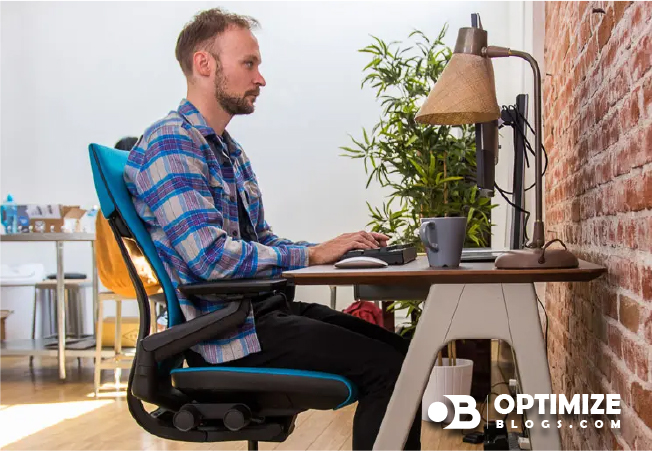
In today's digital age, many of us spend a significant portion of our lives working at a desk or in front of a computer. Whether you work from home or in a traditional office setting, the importance of your office setup cannot be overstated. An ergonomic office setup not only enhances productivity but also contributes to your overall health and well-being. In this comprehensive guide, we will explore the principles of ergonomic office design, the benefits it offers, and practical tips to create an ergonomic workspace that works for you.
Understanding Ergonomics
Ergonomics is the science of designing the workplace and tools to fit the capabilities and limitations of the human body. The primary goal of ergonomics is to create an environment that minimizes the risk of discomfort, injury, and fatigue while maximizing productivity and efficiency. A well-designed ergonomic workspace takes into account the physical and psychological needs of individuals.
The Importance of Ergonomics in the Office
An ergonomic office setup is crucial for several reasons:
Enhanced Comfort
An ergonomic workspace minimizes discomfort, such as back pain, neck strain, and wrist fatigue, allowing you to work for longer periods with less physical stress.
Increased Productivity
When you're comfortable, you're more focused and efficient. Ergonomic design can boost your productivity by reducing distractions caused by discomfort.
Injury Prevention
Ergonomic adjustments help prevent musculoskeletal disorders (MSDs), such as carpal tunnel syndrome and lower back pain, which can result from poor workplace design.
Improved Posture
Ergonomic setups encourage better posture, reducing the risk of developing chronic posture-related issues.
Mental Well-Being
A well-designed workspace can positively impact your mental health by creating a comfortable, stress-free environment.
Key Elements of an Ergonomic Office Setup
Creating an ergonomic office setup involves optimizing various aspects of your workspace:
Desk and Chair
Adjustable Desk Height
An adjustable desk allows you to change between sitting and standing positions. This variation reduces the strain on your back and neck caused by prolonged sitting.
Ergonomic Chair
Invest in an ergonomic chair that supports the natural curve of your spine, provides lumbar support, and allows for seat height and armrest adjustments.
Monitor Placement
Monitor Height
Position your monitor at eye level to avoid neck strain. You can use a monitor stand or an adjustable monitor arm for this purpose.
Monitor Distance
Keep your monitor at arm's length to maintain a comfortable viewing distance and reduce eye strain.
Keyboard and Mouse
Keyboard Position
Place your keyboard at a height that allows your elbows to stay close to your body and your forearms parallel to the ground. Use a keyboard tray or an ergonomic keyboard if necessary.
Mouse Comfort
Aim for a mouse and mouse pad that support a neutral wrist position to minimize wrist strain.
Lighting
Natural Light
Whenever possible, position your workspace near a source of natural light to reduce eye strain and improve mood.
Task Lighting
Use adjustable task lighting to illuminate your work area, ensuring that there are no glare or shadows on your screen or documents.
Cable Management
Keep cables organized and out of the way to prevent tripping hazards and create a tidy workspace.
Foot Support
If your feet don't rest comfortably on the floor, use a footrest to maintain proper posture and reduce lower back pressure.
Ergonomic Accessories
Consider ergonomic accessories like a document holder to reduce neck strain while reading documents, or a laptop stand to elevate your laptop screen to eye level.
Tips for Creating Your Ergonomic Workspace
Here are some practical steps to set up an ergonomic office space that suits your needs:
Assess Your Needs
Begin by evaluating your daily tasks, work habits, and any discomfort you experience. Identify areas of improvement in your current workspace.
Invest in Quality Furniture
Prioritize the purchase of an ergonomic chair and an adjustable desk, as these are the cornerstones of an ergonomic office setup.
Proper Chair Adjustment
Adjust your chair to support your lower back and keep your feet flat on the floor or on a footrest.
Monitor Placement
Position your monitor at eye level, ensuring that the top of the screen is at or just below eye level.
Keyboard and Mouse Position
Keep your keyboard and mouse within easy reach, with your wrists in a neutral position.
Take Breaks
Regularly take short breaks to stretch, stand, and move around. This prevents stiffness and promotes circulation.
Use Ergonomic Accessories
Consider adding ergonomic accessories, such as a keyboard tray or a laptop stand, to further customize your workspace.
Organize Cables
Use cable management solutions to keep cables tidy and prevent clutter.
Lighting Adjustment
Ensure your workspace is well-lit, with adjustable task lighting to reduce glare and eye strain.
Personalize Your Workspace
Customize your workspace with personal touches, such as plants or artwork, to make it a pleasant and motivating environment.
Conclusion: A Healthier, More Productive Work Environment
An ergonomic office setup is not a one-size-fits-all solution; it's about creating a workspace that caters to your specific needs and promotes your well-being. By investing in ergonomic furniture, making thoughtful adjustments, and paying attention to your comfort, you can create an office environment that enhances productivity, reduces the risk of injury, and contributes to your overall health and happiness. Remember that small changes in your workspace can lead to significant improvements in your work experience, ensuring that your office becomes a place of comfort, efficiency, and inspiration.






